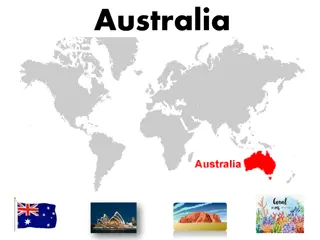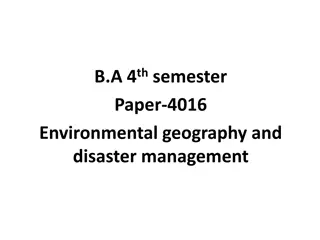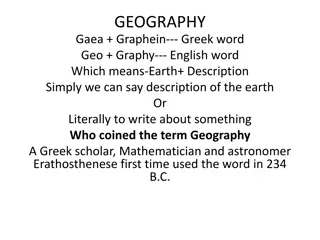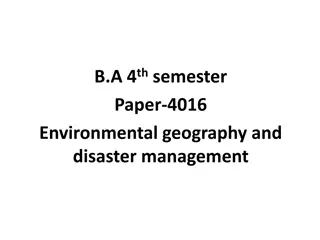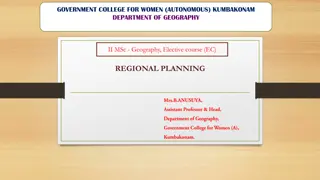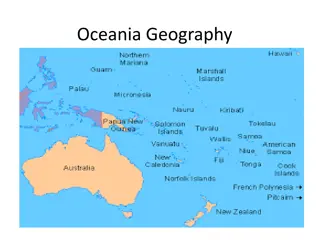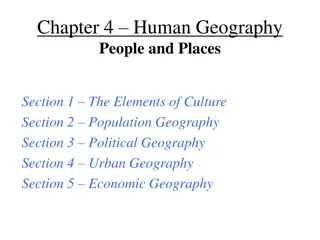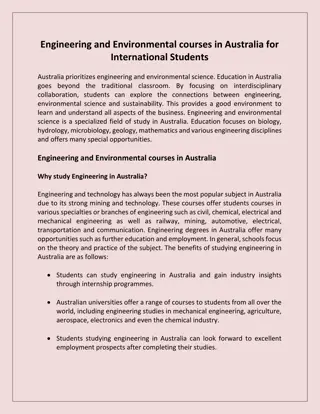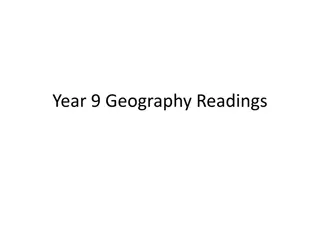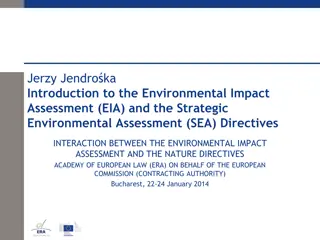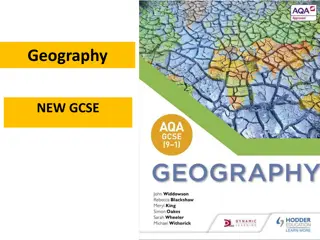Australia - Overview of Geography, Government, and Environmental Challenges
Australia, officially known as the Commonwealth of Australia, is a federal parliamentary state with a constitutional monarchy. The country has a unique landscape, facing challenges such as water management due to its dry climate. Climate change impacts are also a significant concern, making Australia one of the most vulnerable wealthy nations. With a population of around 23.6 million, Australia grapples with issues related to water scarcity, river systems, and climate change effects.
Download Presentation

Please find below an Image/Link to download the presentation.
The content on the website is provided AS IS for your information and personal use only. It may not be sold, licensed, or shared on other websites without obtaining consent from the author.If you encounter any issues during the download, it is possible that the publisher has removed the file from their server.
You are allowed to download the files provided on this website for personal or commercial use, subject to the condition that they are used lawfully. All files are the property of their respective owners.
The content on the website is provided AS IS for your information and personal use only. It may not be sold, licensed, or shared on other websites without obtaining consent from the author.
E N D
Presentation Transcript
AUSTRALIA Fonte: http://global.britannica.com/place/Australia
LOCALIZAO Link: http://global.britannica.com/place/Australia
Official name Commonwealth of Australia federal parliamentary state (formally a constitutional monarchy) with two legislative houses (Senate [76]; House of Representatives [150]) Form of government British Monarch: Queen Elizabeth II, represented by Governor-General: Sir Peter John Cosgrove Head of state Head of government Prime Minister: Malcolm Turnbull Capital Canberra Official language English Official religion none Monetary unit Australiandollar ($A) Fonte: http://global.britannica.com/place/Australia
Population (2014 est.) 23,557,000Collapse Total area (sq mi) 2,969,976 Total area (sq km) 7,692,202 Urban: (2011) 89.2% Rural: (2011) 10.8% Urban-rural population Male: (2011) 79.7 years Female: (2009) 84.2 years Life expectancy atbirth Male: not available Female: not available Literacy: percentage of population age 15 and over literate GNI per capita (U.S.$) (2013) 65,520
1. Water It's hardly surprising that on the world's driest inhabited continent, experts are concerned about how Australia looks after its water. "We need to get smarter about how we manage water that means everything from replacing our ageing infrastructure to ensuring we capture rain water when it does fall," urges Kim McKay, author of True Green Life. "Most rivers in southern Australia are suffering from decades of over- extraction for irrigation," says Dr Linda Selvey, Greenpeace Australia Pacific CEO. "This is being exacerbated by drought, and the pressure will continue as climate change takes hold." Selvey and former Australian of the Year, Tim Flannery, are some of the many voices calling for urgent action in the Murray-Darling Basin, while the Australian Conservation Foundation (ACF) continues to remind the public of the far-reaching effects of unhealthy river systems in general. "Blue-green algal outbreaks kill fish and make water unsafe for drinking or swimming, while salty water isn't useful for anything," ACF spokesperson Josh Meadows said. Fonte: http://www.abc.net.au/environment/articles/2009/12/07/2764044.htm
2. Climate change It may be a global issue, but when scientists across the world are asked what the effects of climate change will look like, they quickly point to Australia. "Of all the wealthy countries, we're probably the most vulnerable," says Professor Will Steffen, executive director of ANU's Climate Change Institute. "We're locked in to another 0.5 C temperature rise due to past emissions, but what we do between now and 2050 is crucial for the magnitude and rate of climate change later this century and beyond," he says. While government assessments predict over 250,000 Australian homes may be at risk from rising sea levels, Greenpeace's Selvey notes climate change will affect us well beyond our front doors. "Climate change also concerns security, the economy and justice. As a doctor, I've also seen the way it affects people's health," she says. The response, urges Professor Kurt Lambeck, president of the Australian Academy of Science, must be urgent and adaptable: "Reducing greenhouse gas emissions must be high priority, even if the full consequences of this are not yet understood," he says.
3. Energy "We should be replacing fossil fuels with renewable power," says Selvey. "It's critical that the Rudd government act to help us with the transition. It can be done; all that is required is political will," she says. Fiona Wain, CEO of Environment Business Australia, sees an opportunity in the coming energy crisis. "We have capacity to be world leaders in solar, wind, marine and geothermal energies. We have these resources on tap, but we've become lazy thinkers. Why don't we do minerals processing and manufacturing in Australia using these energy-efficient resources?" Like Flannery, who believes a lack of triple-bottom-line accounting in government and industry is costing the environment, Wain says those in manufacturing need to shift their thinking, and fast. "It's time to be thinking very big picture, so we need boards of directors that can think further than their three-year term of office," she says.
4. Coal Tim Flannery is not the only expert surveyed who expressed serious concern over Australia's 20-odd conventional coal-fired power plants. "We're the biggest coal exporter in the world," says McKay. "We may think our global carbon contribution is small (almost two per cent of global emissions), but it's much, much greater than that due to our bulk coal exports to countries like Japan, South Korea, the Netherlands and China." "It's unbelievable we haven't developed alternative, renewable energy sources on a large scale. We're dragging the chain presumably due to short-term, next election- cycle thinking," she says. While brown coal is responsible for much of our carbon dioxide (CO2), Wain believes we should be further investigating sequestration of the climate-changing gas. "Regardless of what else we do we're still going to need to draw down CO2 from the atmosphere to get it to 350 parts per million." Wain points to a commercial trial aiming to turn CO2 captured from coal-fired plants into algal oil (to produce plastics or biodiesel); and another trialling brown coal deposits as the base for soil fertilisers as two potential solutions. "There are consortiums of developers just getting on with it," she says.
5. Biodiversity With 1500 land-based species threatened, what Flannery terms "the extinction crisis" is agreed upon as a serious environmental challenge. "We have already seen a fairly disturbing loss of our biodiversity, but the problem tends to get overshadowed by climate change, land degradation and water issues," says the ANU's Will Steffen. "There's a whole suite of services we enjoy thanks to a biodiverse-rich ecosystem, from provisioning services like food or water, through to nutrient flow and pollination," reminds Steffan. He believes our highly urbanised society only compounds the problem. "We are quite disconnected from the services our ecosystem provides. Aside from products like food or timber, we don't see a value or price for these services in an economically focussed system. But Australia has an extinction debt building up, and the trend is not improving," he says.
6. Oceans Despite knowing the problems faced by one of our best-loved tourist attractions, we're still not doing enough to protect the Great Barrier Reef. "Rising sea levels and the impact of fertiliser run-off are damaging the reef. It needs more attention, because once it's gone, it's gone for good," reminds McKay. As the ACF calls for a national network of large marine sanctuaries, and an Australian Oceans Act to regulate sustainable harvesting and production of seafood, Greenpeace's Selvey highlights the current situation. "Seventy-six per cent of the world's fisheries are in dire straits, and overfishing by commercial and illegal fleets is threatening to fish some of our favourite seafoods to extinction. If we continue on this trajectory all fish stocks will collapse within 50 years. Scientists say eventually we will be left with only jellyfish and plankton," she says.
7. Population With Australia's population projected to reach 35 million by 2049, commentators continue to express concern about the pressure this growth will place on resources. "It means more consumption, and greater challenges for providing infrastructure to manage our country in a sustainable way," says McKay. While the ACF is calling for long-term strategies to meet and increase humanitarian obligations while reducing overall migration to more sustainable levels, the debate over ideal population continues. Experts may not see eye to eye on a figure, but most agree decisions need to be made. "We need to determine what our carrying capacity is" says Lambeck, "and how can we achieve a sustainable population."
8. Sustainable cities With Australians using more water and energy per person than almost any other country in the world, rethinking how we live in and develop our cities is vital, says the ACF's Josh Meadows. "We should invest in energy-efficient houses and buildings, and then export our ideas and the smart technologies behind them." Lambeck says smarter infrastructure would go along way to addressing the issue: "We need sustainable infrastructures for transport, power generation and distribution that minimise the impact on energy, water and biodiversity." According to Wain, there is huge scope for greater efficiency in our built environment. "I'm an eternal optimist, but we need to think at scale not house to house, but street to street and suburb to suburb. We need solutions that are scalable, so they become more investable and bankable."
9. Transport The perennial debate about lack of investment in public transport continues to frustrate many experts. "People complain about the per capita cost of investment in public transport, but it's far cheaper than the cost of putting cars on the road. We're not very logical in the way we think about these things," says Wain. While the ACF points out that removing the "nonsensical fringe benefit tax concession" for company car use would shift many away from relying on their cars, Wain is excited by the planned roll-out of a national electric car network, beginning in Canberra within the next two years. "Programs like this could conceivably take all tailpipes off the road in our cities," she says
10. Ourselves While the majority of surveyed experts highlighted the need for government action, and fast, it seems the buck doesn't stop there. "We elect our leaders and we have the right to hold them to account," reminds Selvey. "We can pick up the phone to call our MP, write a letter, or visit them in their constituency office. Companies are doing it to protect their interests, we need to do it to protect ours." Lambeck says educating ourselves is key. "We need a population that understands the issues, and can make constructive contributions to the debate to force politicians to develop longer than three-year 'solutions'," he says. What stands in the way, McKay believes, is apathy. "It manifests in the politician who would prefer to do the minimum rather than risk not being re-elected; or in business leaders who adopt a 'business as usual' approach to ensure their annual bonus. "It's also in you and I ignoring the issues and hoping they'll go away. I've seen people come together and change things, and I really believe we can learn to live in a more harmonious and sustainable way."
ProjectingFuture Change Estimating future changes in sea level is a complex process. Our understanding of future projections is greatly improved by our review of historical change and our assessment of natural variability. The basis of this approach is: 1. estimation of historical change; 2. estimation of (short term) natural variability; and 3. projection of long term change.
Estimates of recent global sea level change have been significantly improved following the introduction of satellite altimeters in late 1992, refer to Figure 2. It is now accepted that global sea level has risen over the past two centuries. Following a period (about 2000 years) of little change, global sea level began to rise at the start of the 19th century (CSIRO 2009) and has continued through the 20th century. The rate of rise over the 20th century was an order of magnitude larger than the rate of rise over the two millennia prior to the 18th century (Church et al. 2007). In addition, reconstruction of historic recordings indicates that there has been a statistically significant increase in the rate of rise from 1870 to 2004 (CSIRO 2009).
LINK: http://www.transport.wa.gov.au/mediaFiles/marine/MAC_R_SeaLev elChangeInWesternAustraliaReport.pdf Abrir pdf
This report has been prepared to review the current information on mean sea level variation along the Western Australian (WA) coastline, and to provided recommendations on an appropriate allowance for mean sea change to be used in coastal planning. It draws extensively from the existing work undertaken by the Intergovernmental Panel on Climate Change (IPCC), Commonwealth Scientific and Industrial Research Organisation (CSIRO), and the Antarctic Climate and Ecosystems Corporative Research Centre (ACE CRC). In reading this report it should be understood that mean sea level change, although in many instances a dominant factor, is only one of the key environmental variables that may be effected by climate change. These key environmental variables include: meansealevel; oceancurrentsandtemperature; windclimate; waveclimate; rainfall/ runoff; and airtemperature.
Australia's 2030 Emission Reduction Target The Australian Government has agreed a target of 26-28 per cent below 2005 levels by 2030. Our target is a step up from Australia s current target to reduce emissions to five per cent below 2000 levels by 2020. Australia s 2030 target is a strong, credible and responsible contribution to climate action, as countries work to conclude a new global agreement at the Paris climate change conference in December 2015. It builds on Australia s track record of addressing climate change and is consistent with strong economic growth and jobs. Fonte: http://www.environment.gov.au/climate-change/international
LINKS: http://www.australia.gov.au/information-and- services/environment http://www.environment.gov.au/







